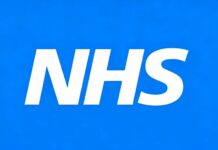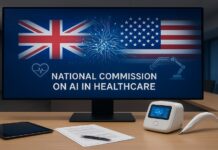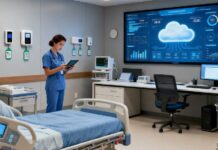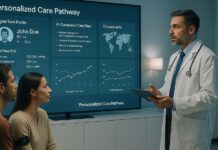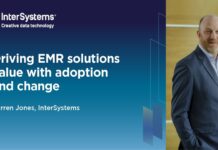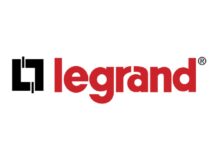The healthcare industry is undergoing a transformational shift, with digital technologies playing a core role in transforming traditional systems and modernizing healthcare infrastructure. At the forefront of this change is Healthcare Software as a Service (SaaS), which has changed the way healthcare providers practice and deliver services, as well as engage patients.
Healthcare SaaS is a cloud delivery model that enables organizations to use software applications from an online platform, avoiding cumbersome on-premises infrastructures. By aligning with contemporary infrastructure demands, Healthcare SaaS is revolutionizing workflows, efficiency, and patient-centered care.
Connecting Technology to Modern Healthcare Needs
Modern healthcare infrastructure requires a balance between scalability, efficiency, and patient outcomes. In the past, healthcare organizations relied on hardware-centric solutions that were slow to adapt, expensive, and somewhat rigid. Healthcare SaaS has provided a way out of these limitations, offering solutions that are specific to the needs of hospitals, clinics, and long-term care providers, and are real-time enabled in a way previously implausible.
Fundamentally, Healthcare SaaS brings stakeholders together—healthcare providers, patients, and administrators—via integrated platforms. It reduces the information silos that are otherwise endemic to the industry, facilitating ease of collaboration and enhancing infrastructure as a whole.
Across patient management systems, electronic health records (EHRs), telemedicine platforms, or even supply chain logistics, Healthcare SaaS redefining healthcare by offering scalable solutions to suit the fast-changing nature of contemporary medicine.
Enhancing Operational Efficiency
Healthcare organizations are mostly challenged by operational inefficiencies, which can reduce their ability to deliver high-quality care. Healthcare SaaS directly confronts this challenge with greater automation, simplified workflows, and better use of resources.
Automation is one of the pillars of Healthcare SaaS. There are functions and processes that require manual processes in healthcare, like scheduling patients, managing medical records, and patient billing, are now largely function using smart systems such as SaaS. Additionally, digitized systems reduce redundancies, minimize errors, and save valuable time for medical providers.
SaaS allows administrators to use real-time data analytics to make timely and informed decisions. For example, resource management systems can forecast patient admission trends that can help hospitals distribute beds, agency staff, and medical equipment accordingly. Combined with SaaS-based inventory systems, hospitals always know what inventory is in stock and can make optimal use of it while controlling purchasing trends to avoid over-purchasing. This limits waste and reduces expenses.
Another key benefit is the capacity to consolidate heterogeneous systems in a healthcare facility. Radiology laboratories to pharmacy sections, SaaS platforms consolidate data and processes, help in inter-departmental coordination, and eliminate delays.
Supporting Patient-Centric Care
Modern healthcare infrastructure is patient-centric, with highly focus on personal preferences, needs, and outcomes. Healthcare SaaS is critical to making this true realignment possible by providing products that maximize patient experience at every touchpoint of the pathway of care.
One of the most powerful features of Healthcare SaaS, and more importantly, the user experience as a whole, is the ease of access to one’s own electronic health records. Patients are able to see their own medical history, lab results, and treatment plans through accessible portals, enabling them to actively participate in the management of their own health. Transparency builds trust and enhances patient engagement.
SaaS-enabled telemedicine platforms have changed the face of accessibility in healthcare. In a future where patients are more accustomed to virtual consultations, remote monitoring, and digital follow-ups, transitioning away from retaining care in geographic locations will truly allow patients timely care, no matter where they are.
Also, SaaS applications have predictive analytics that can determine patients at risk and suggest early interventions. For instance, a SaaS application can mark a patient who is likely to develop a chronic condition, which can lead to early intervention and diagnostic by healthcare providers. These tools not only enhance results but also lower the total cost of care.
Personalization is yet another sphere in which Healthcare SaaS redefining healthcare stands out. With the help of data from wearable devices, genetic makeup, and lifestyle details, SaaS solutions allow healthcare professionals to develop customized treatment plans. Such customization makes patients happier and interventions more effective.
Security and Compliance in SaaS Healthcare
Data security is still one of the biggest issues facing the healthcare sector, particularly with the move towards cloud-based solutions. Healthcare SaaS meets this issue by incorporating strong security protocols, so sensitive patient information can be safeguarded from breaches and unauthorized use.
Encryption is one of the hallmarks of SaaS platforms, protecting data in transit and at rest. Multi-factor authentication and role-based access controls also limit unauthorized access and ensure that only authorized staff can access or update patient data.
Compliance with healthcare regulations, including HIPAA and GDPR, is another important area of SaaS platforms. The platforms are developed with predetermined regulatory compliance, enabling organizations to follow compliance standards for cloud computing.
SaaS solutions come with audits and updates to ensure technology security and compliance with evolving regulations. This is especially important with increasingly sophisticated cyber threats, which mandate proactive approaches to protect healthcare information.
Scalability and Cost-Effectiveness
One of the most notable aspects of Healthcare SaaS is scalability. In contrast to more conventional systems that necessitate huge investments in hardware, SaaS platforms are used to increase the scale of the business. Whether it is a small clinic or a vast hospital network, SaaS solutions can be scaled to meet high and challenging demands.
This scalability can also be applied to data storage, user access, and capabilities within the system. Where patient volume builds up or new services are being added, SaaS systems can be scaled up without carrying out large-scale changes to infrastructure. Organizations are also able to scale down in phases of low activity, promoting cost-effectiveness.
The cost-effective nature of SaaS is also driven by its subscription-based pricing model. Healthcare organizations only pay for what they utilize, excluding the initial investment required in legacy software. This is especially valuable for the low-budget small facilities, allowing them to access the latest and greatest technology without destroying their bottom line.
The Role of AI and Analytics in Healthcare SaaS
AI and sophisticated analytics are essential components of the success of Healthcare SaaS platforms. They provide companies the ability to derive actionable insights from large amounts of healthcare data, leading to better decision-making and results.
AI-driven algorithms can examine patterns, forecast results, and highlight inefficiencies across healthcare operations. For example, predictive analytics can estimate patient demand on an everyday basis for hospitals to use resources more efficiently and effectively. Likewise, AI can uncover subtle patterns in patient data that are often imperceptible to human analysis, which can ultimately lead to quicker diagnoses and interventions.
Moreover, SaaS platforms can also enhance population health management from the macro perspective by taking the overall data and identifying trends across population groups and effectively closing the gaps to implement specific interventions. For example, analysis may show that there is a high rate of a certain chronic condition in a population group. This may result in public health interventions or allocating resources to deal with the problem.
The Future of Healthcare SaaS
As medicine advances, the role of SaaS will also grow in supporting modern infrastructures. Future tools – including blockchain, augmented reality (AR), and the Internet of Medical Things (IoMT) – will be integrated into SaaS platforms, creating a higher level of interoperability than presently seen.
Blockchain technology can help solve issues of interoperability and data security by providing a decentralized way to store and share health data. Current health care delivery, including telehealth, although mostly isolated to patient demographic benefits, is most advantageous to rural populations and individuals with limited mobility.
Arguably, defining it as a limited risk initiative at best before defining an appropriate best practice. This ensures the data is secure and available to those who have authorized access.
Augmented Reality is another arena of health care that holds potential for training and learning in medical education and assessment environments. For example, if AR was utilized with SaaS products, health care professionals would have powerful immersive application tools to be used to train and assess their diagnostic capabilities, therefore their accuracy.
The IoMT is a network of interrelated healthcare devices that will create huge amounts of real-time health data. This data will also be aggregated in SaaS platforms to provide complete views of an individual’s health, allowing for proactive care and better care outcomes.
Conclusion: Building the Future with Healthcare SaaS
Healthcare SaaS is more than a technology solution; it is a redundancy for the future of healthcare infrastructure. By maximizing operational efficiency, enabling patient-centric care, and maintaining security and compliance, SaaS platforms are enabling healthcare organizations to tackle future challenges.
With the accelerating growth of technology, the scope of Healthcare SaaS will keep growing, shaping innovations that rethink the way care is received and provided. For healthcare stakeholders, adopting SaaS is not an option but an imperative in creating an enduring and effective future for the sector.


